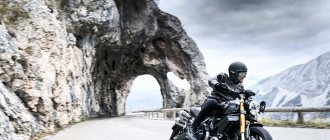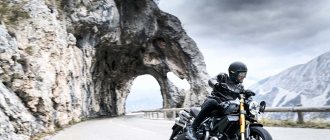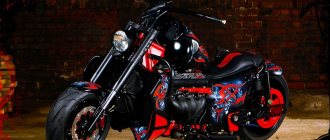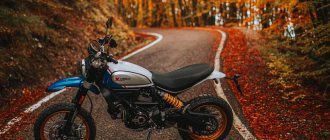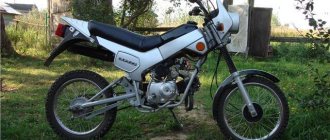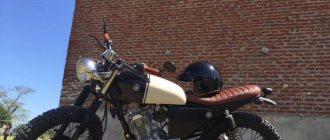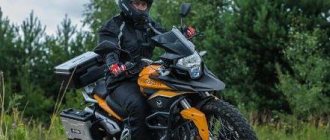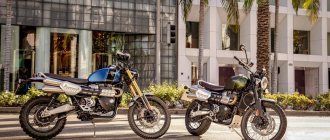Over the past decade and a half, the production motorcycle market has been heavily influenced by cafe racers, which has ultimately led to the emergence of many production models. The custom craze that's pervading the motorcycle world has led to a resurgence in scramblers. These vintage off-road bikes are now produced by most motorcycle companies, with some brands basing entire product lines on retro styles.
The growing interest in the scrambler genre has provided motorcyclists with a wide range of different options currently available on the market. While all of the mentioned models on our list fall under the scrambler look, their features, performance, and build quality can vary greatly. So, to help you figure out which scrambler to choose, we've put together this guide to 13 scrambler-style motorcycles.
History of the scrambler
Although it is difficult to pinpoint an exact time or place, many agree that scramblers originated in England. Around the 1920s, motorcycles had only been around for a few decades and were just beginning to evolve into custom designed machines, purpose built from the ground up, rather than bicycles that were powered by a primitive, slightly modified engine. The concept of a purpose-built production off-road motorcycle was still on the horizon for nearly half a century, although early riders were nonetheless eager to get off the road and into dirt and off-road riding.
Enthusiasts organized early off-road races and gave participants only the starting point, azimuth and finish. How the rider would get there or how he chose to overcome the obstacles and terrain along the way was entirely up to him. To compete in these events, drivers had to use production models that were built for street use, as, again, there really was no alternative at the time. To make their rides more off-road friendly, riders stripped their bikes down to their bare essentials and often beefed them up to better withstand the rigors of off-road conditions.
Initially, these cars were mostly built in garages by enthusiasts without any help or support from the manufacturers. Eventually, these customs and the local races they competed in became popular. Attracting the attention of various large companies, including manufacturers of spare parts, as well as chassis and engineering equipment.
By the 1960s, manufacturers began producing production scrambler models that were sought after for their off-road capabilities while still being suitable for regular street riding. And right from the exhibition hall you could go off-road. But in reality they were still, for all intents and purposes, street bikes, with modified performance.
By the 1960s, manufacturers began producing scramblers of their existing models. For example, Honda introduced several iconic versions of its bikes, although instead of being marketed under the CB (or "City Bike") designation, these Japanese models were nicknamed "CL" - off-road-ready motorcycles ranging in displacement from 49 to 450 cc. cm. And although they had tall pipes, wide handlebars and all that jazz, they were still heavy cars that were not particularly suitable for hardcore off-road driving.
Similar models
Scramblers are far from the most popular class of motorcycles, so there are practically no production models that could at least be classified in this class. Such bikes are usually made by hand by customizers, and the donors among craftsmen can be very different. However, several motorcycles still perform on the same field with the BMW R Nine T:
- Ducati Scrambler. The only thing it has in common with its Bavarian competitor is its claim to belong to the class of scramblers. It looks no less stylish, but, inferior to the R Nine T in terms of technical characteristics, the Ducati Scrambler costs much less. Although still, of course, a lot.
- Ducati Scrambler 1100 Sport. Externally and structurally it is very similar to its younger brother, but in terms of characteristics it can compete with BMW. It costs about the same.
- Triumph Bonneville T120. English dude, a real dandy. The price tag is not at all humane. In terms of characteristics, it is quite capable of competing with the Bavarian, but structurally the Englishman is much simpler. Maximum of good old hardware, minimum of electronic bells and whistles.
The Rise of Motocross
The Point A to Point B races in the UK have become closed off-road circuits. The popularity of desert racing also exploded around this time, and as a result, a number of specialist companies began creating increasingly capable dedicated framesets, such as the iconic Rickman Metisse scramblers.
From this point on, manufacturers began experimenting with more and more specialized off-road motorcycles, producing increasingly better machines. However, in 1966, everything changed when four-time 250 cc world champion, Swedish-born Thorsten Hollman, introduced a new off-road model from Husqvarna. Hollman continued to absolutely dominate every race he entered and in the process he coined the term "motocross" to describe a new, lightweight style of off-road motorcycle.
From this point onwards, scramblers tended to lose weight, being steadily replaced by increasingly modern, increasingly powerful machines with more power, less weight, more agile handling, noticeably superior suspension and overall improved handling. With the advent of dedicated production off-road models now available from dealerships, there was no longer a need to modify road bikes for off-road use, and thus the original scrambler models became extinct.
What is a Scrambler motorcycle?
Like the original scramblers of mid-century England, the modern exponents are essentially stripped-down bikes that have been stripped of any and all unnecessary components and then fitted with a variety of equipment and upgrades to make them more travel-friendly.
Scramblers also have a distinctive appearance, largely due to their intended purpose and intended use. Because these cars were usually driven in short bursts during competitions and were not intended for long trips. Scramblers tend to have relatively small fuel tanks, often with small dents in the knees or fitted with rubber bump stops. Because the rider must be able to move freely around the saddle, throwing it into corners and the like, the scrambler boasts distinctive, thin, flat seats that often end in a subframe with hoops.
The Scrambler features long-travel suspension, low-range gearbox, high fenders, spoked wheels, knobby tires, wider handlebars and hand, engine and headlight protection. There are also exhaust systems and pipes that are located high off the ground on the bike, where they are protected from rocks, logs or other obstacles that could harm the low-hanging muffler. The side number plates on these bikes are associated with competition use.
Another classic hallmark of the original Scrambler motorcycles was their overall simplicity. Besides the fact that these bikes were already spartan and rather stripped down, they were designed for off-road riding and were typically used in very challenging riding situations. With a minimum number of parts that can fail, break or be damaged.
As a result, almost all scramblers of yesteryear used air-cooled engines that were almost single or twin cylinder. And while multi-cylinder engines have become noticeably more common on production models today, the lion's share of modern scramblers produced are still powered - mostly air-cooled.
Pros and cons of the BMW R Nine T
Advantages
- Crazy acceleration dynamics. The bike picks up speed breathtakingly quickly.
- Great brakes with ABS.
- Stylish appearance. It is, of course, designed for a certain category of motorcyclists who gravitate toward retro bikes, but one cannot help but admit that the design of the R Nine T really came out great.
- A large number of additional options offered by dealers: heated grips, ESA, several engine operating modes controlled by a button on the remote control, tire pressure sensors, electronically adjustable suspension and much more.
- Subjective ease. The BMW R Nine Ti weighs about 220 kg, but thanks to the boxer engine, which significantly lowers the center of mass, the motorcycle subjectively does not seem heavy at all.
- High quality build and all components. There are no complaints here at all - it's BMW!
Flaws
- High price. Maintaining a motorcycle is also not very cheap, so you should soberly assess your financial capabilities before purchasing.
- Decent fuel consumption. At 130 km/h, according to reviews from BMW R Nine T owners, over a hundred kilometers the bike consumes 6 liters of gasoline or more.
- Lack of wind protection (except for the Racer modification, where, however, it is still not very effective).
- Rigidity. Of course, you have to pay for style, but sporty stiff suspension and an equally hard seat do not add comfort.
- Uncomfortable passenger seat. It seems to be there, but it is of little use - if you go somewhere far away, then after a hundred kilometers the passenger will run away and walk home, just to avoid getting back on.
The Modern Rise of the Scrambler
While the first wave of scrambler motorcycles died out in the 1970s, the segment experienced a major resurgence in the mid-aughts. Soon after reviving the iconic Bonneville line, Triumph continued the revival with the release of the Bonnie variant, complete with tall bars, high suspension, knobby tires and an overall design in the style of early Triumphs. The enormous success of this new Bonneville encouraged other major manufacturers to follow suit.
Over the next decade, more and more motorcycle companies began introducing their own scrambler models, sometimes as versions of existing offerings and sometimes as specially designed products. Brands such as Yamaha and BMW introduced scramblers as part of their traditional model ranges, companies such as Moto Guzzi and CCM introduced scrambled versions of models already in their line-up, and Ducati introduced an entire product range under the Scrambler Ducati name, which in less than a year, already accounted for more than a quarter of all Ducati sales.
Interesting news on the topic
BMW cars will wish their owners a Happy New Year
No, you shouldn’t expect firecrackers and champagne here, but a couple of solemn phrases coupled with a little surprise will still lift your spirits December 24, 2020
BMW X7 made into a jeep
Who said that crossovers are not SUVs? The Manhart studio definitely doesn’t think so and is proving it in practice with its new project December 16, 2020
BMW advertises Mercedes and vice versa
Motorpage readers may remember the Deutschmark poster war, where both trolled each other and their products. Now this confrontation has reached a new level - companies began to advertise each other December 11, 2020
BMW designer promised to release something beautiful
We are talking about the fourth series of BMW, where a liftback will be added to the already existing coupe and convertible, which will be very beautiful November 30, 2020
BMW will recall crossovers in Russia due to the risk of loss of control
The German company will send new crossovers X5, X6 and X7 for repair to replace the front subframe November 25, 2020
BMW Z4 and Supra recalled due to fire hazard
The US National Highway Traffic Safety Administration has issued a recall for the BMW Z4 and Toyota Supra. A small number of sports cars are due for unscheduled repairs, but the reason is significant: they have defective fuel tanks November 23, 2020
BMW cars began warning owners about cameras on the roads
BMW has launched a new Traffic Camera Information feature as part of its ConnectedDrive package, which alerts drivers to the location of traffic cameras. The German company began offering this technology for some vehicles for the 2022 model year on November 17, 2020
BMW's flagship electric crossover declassified
BMW presented a prototype of the iX crossover, which will become the technological flagship of the brand's electric line November 11, 2020
Herald Scrambler 125
The Scrambler 125 is a small Chinese motorcycle that has been styled to look like a scrambler. This low-powered (9.6 hp) bike with a low-mounted exhaust is more designed to simply give off-road vibes, and is clearly designed almost exclusively for on-road use. Weighing in at around 125kg, it's a nimble little bike that will be easy to learn on. And despite the lackluster reputation of many Chinese-made motorcycles, Herald's products are actually pretty good little bikes that are surprisingly reliable and come with some modern touches like LED lighting and adjustable fenders. It's an affordable option that mimics the styling of the old Triumph Bonneville, with a scrambler-style flat seat, triangular subframe, knobby tires, forks and headlight grille. Thanks to its low seat height (and low curb weight), this model is also great for shorter riders.
Bullit Hero
The Bullit Hero is an incredibly attractive and affordable bike. Even though Bullitt is a British company, the company sources its models from China, which allows them to sell their products at such affordable prices. The model is equipped with a tubular steel chassis housing a single-cylinder, fuel-injected, air-cooled engine protected by a plate. Combined with the knobby tyres, headlamp grille and tall Supertrapp style canister, this 125cc air-cooled bike really boasts real potential when the tarmac runs dry. And while this model is available in a variety of regular cool patterns, the company also offers several special edition models.
Buy accessories, equipment, spare parts:
Go to the store
Husqvarna Svartpilen 401
By far the most modern take on the scrambler genre, Husqvarna's Svartpilen 401 is a sleek city bike, blessed with a futuristic off-road flare in the form of a skid plate, spoked hoops and integrated luggage racks. Built on KTM's proven 390 platforms, the 401 features a surprising number of high-tech components—especially considering its $5K MSRP—including a slipper clutch, electric throttle and WP APEX suspension front and rear. Despite weighing a light 150kg, the little entry-level Husqvarna's 5.7-inch ground clearance means it'll be ridden largely on tarmac.
Mash X-Ride Classic 650
A superbly designed French motorcycle, it was clearly inspired by the old Yamaha DT models. This machine has a wide range of elements that evoke the spirit of cars of yesteryear, such as its gold anodized wheels and blacked-out transmission. The bike also boasts a host of modern features including LED lighting and a dual muffler exhaust. With its tall fenders, wide handlebars, knobby rubber and skid plate, the X-Ride Classic 650 feels quite confident in the mud. The model has yet to hit showrooms and pricing has yet to be announced, although it is expected to be priced the same as other existing Mash Motor 650 models, which is around $6k. Engine: 644 cc cm air-cooled, 40 hp.
Yamaha SCR950
At the beginning of the YardBuilt program, Yamaha turned to Greg Hageman, who at the time was operating under the Doc's Chops brand. The company was so pleased with Hageman's work that they made a few minor changes and put him into production, resulting in a Japanese V-Twin-powered car. A stunningly unique design from one of Japan's Big Four, the SCR boasts quintessential elements of both cruisers and scramblers. Despite the SCR branding, this bike's nearly 250kg curb weight, narrow front fender, low-hanging exhaust and meager 5.5-inch ground clearance mean it's better off on the road for the most part. Engine: V-twin 942 cc engine cm air-cooled and 51 hp.
According to the laws of style
The basis for the Bavarian scrambler was the classic BMW R nineT model, which made a lot of noise a couple of years ago and is still one of the brand’s bestsellers. The basis is the most accurate expression that should be used in this case. If you think that the Scrambler is just a nineT restyled and adorned with additional accessories, you are mistaken. These models indeed have a lot in common, but in fact their creators ended up with two completely different motorcycles. Now I will explain why.
BMW R nineT is a niche model. It is designed for nostalgic connoisseurs of classic motorcycles. Moreover, accomplished and wealthy connoisseurs. On the Russian market nineT costs from 1,100,000 rubles. The rather high price, by the way, is completely justified - all the best was used in the design of the motorcycle, no material was cut and no skimp was made on matches. Cool, who would argue! But it was decided to make the Scrambler more widespread, and therefore, inevitably, more accessible. Looking ahead, I will say that costs were reduced wisely, trying not to do harm or spoil anything. In a word, the savings did not come to any harm. Or maybe even the other way around - but this depends on your personal perception of the motorcycle and the requirements for it.
The neoclassic BMW R nineT premiered in 2014. This model was built based on the legendary Bavarian motorcycle R90S exactly for its 40th anniversary. When creating the nineT, BMW focused not on the ultra-modern electronics that all new motorcycles of the brand flaunt, but on impeccable engineering, the highest quality workmanship and high-quality materials. The result was a fairly simple and very “honest” motorcycle, with almost standard driving performance. Moreover, not clouded by all kinds of electronic driver assistants. In the modern motorcycle world, the BMW R nineT occupies about the same place as the classic Swiss “mechanics” in the world of watches.
The first thing that catches your eye when looking at the new BMW Scrambler is the large front wheel compared to the “regular” nineT. Here it is 19 inches, not 17 inches. This makes the brake discs appear smaller, but this is only an illusion. In fact, they are exactly the same and even interchangeable. But the brake mechanisms themselves are different. Instead of expensive radial-mount Brembo monoblocs, the Scrambler uses simpler, collapsible calipers. Also from Brembo, also four-piston, but structurally a little simpler. Can you feel it while driving? Yes, I can feel it. The wheel diameter of a scrambler is larger, which means the load on the brake mechanisms is also greater. Initially, less tenacious, mind you. The result is increased force on the levers and slightly less information content. It’s not critical at all, but if you directly change from one motorcycle to another, it’s noticeable.
The next difference is a different front fork. It is normal here, not inverted, and with a smaller feather diameter: 43 mm versus 46. A little less angle of inclination, a little more reach... But these are the kind of little things that you are more likely to notice on paper, laying out tables of technical characteristics in front of you, than on the road. You can only feel a slightly increased suspension travel. Moreover, not only the front, but also the rear. The difference, compared to the “basic” model, is small - about 5 mm, but when driving on bad roads, for which the scrambler is generally designed, they will definitely not be superfluous!
It turns out there is a difference in the frame design. Honestly, standing next to the motorcycle, I wouldn't have noticed it. Fortunately, there was someone to ask - directly from the chief manager of the Scrambler project who accompanied us during the test. It turned out that some expensive cast elements were replaced with welded ones, and it consists not of four elements, as on the nineT, but of three. As a result, it will not be possible to completely remove the entire rear part of the frame on a scrambler. Although, why remove it? This may only be required by professional customizers when seriously modifying a motorcycle. For everyone else, it’s enough that the “tail” remains removable, and the Scrambler, like the nineT, can be turned into a single-seater by installing a shorter seat.
The saddle itself, by the way, is quite high here. If you check the technical specifications again, it will turn out to be four centimeters higher than on the nineT. This is also another signature feature of all scramblers - the pilot’s seat should be high and vertical. On the BMW Scrambler, this is also facilitated by the rather high steering wheel. You sit behind him, really, straight and comfortably. About the same as on touring motorcycles of the GS series. Now, only the footrests here are clearly too high. The legs are strongly bent at the knees, stronger than on the nineT. And it’s also unlikely that you’ll be able to hit the asphalt with the running board while turning. At least on all the BMW Scramblers that I happened to see during the test, there were no characteristic “notches” on the running boards!
The saddle, and on our motorcycles it was single (this is an option), looks very cool, but still worse than on the concept already mentioned at the beginning. I understand - mass production. The stylish cross stitching was replaced with simple stampings. It looks like it from a distance, but not so much up close. But it’s comfortable to sit, unless, of course, you try to spend eight hours in a row in the saddle. For this class of motorcycles, this is normal. I don’t think anyone would regard the scrambler as a serious long-range weapon. He is not fit for such feats. So, our test mileage was 200-300 km per day and, getting off the motorcycle, I did not feel any discomfort in any part of the body. Including the one you’re probably thinking about right now!
Fantic Caballero 500 Rally
The 500 Rally is one of the lesser known models in the scrambler world, which is a shame because it has a lot going for it. As well as a truly eye-catching look that perfectly blends retro and modern design, the bike features components from leading companies including Tommaselli, Domino, Brembo and Arrow, the latter of which is responsible for the 500s. The model also features a chrome-molybdenum steel center tube frame, 41mm FRS inverted fork and monoshock, both of which are adjustable and provide approximately two-thirds of the travel. With power figures on par with the latest and greatest MX models, this bike is without a doubt one of the most off-road scramblers currently in production. Engine: 449 cc cm with liquid cooling and a power of 40 hp.
Classic exhaust
The raised exhaust with two vertically mounted rear mufflers meets the requirements of a classic Scrambler. It is mounted very close to the body of the motorcycle, giving it an even more compact appearance. The melodious sounding engine meets the new ECE R41-04 noise control standards. The large size of the catalytic converter allows you to purify exhaust gases even more efficiently.
Moto Guzzi V7 II Stornello Scrambler
Moto Guzzi has previously offered scrambler-style accessories and kits for its popular V7 model, and in 2014 introduced the V7 II Stornello Scrambler at EICMA. Although objectively a more street-oriented machine with off-road styling, the V7 II Stornello has no problem tackling trails and the like. Taking inspiration from the Stornello 125cc scrambler. cm late 60s - early 70s. The modern V7 Stornello features many unique elements, such as a welded frame and a stunning high-mount exhaust system from Arrow. Old-school fenders, a wind deflector, side license plates, and spoked rims wrapped in dual sport tires complete the package on this Italian motorcycle. Engine: 744 cc air-cooled with 48 hp.
Calculate and compare MTPL for a motorcycle:
Go to website
BMW R Nine T modifications
- Standard. Everything written above applies to it.
- Scrambler. Alloy wheels with a larger radius instead of spoked ones, a different seat, a simplified instrument panel, a 1-liter smaller gas tank. Conventional brake calipers are also installed at the front instead of radial ones, and the fork was replaced with a regular 43-mm “telescope”. The exhaust pipes also received a new design, and the torque decreased slightly - by 3 Nm.
- Pure. Completely similar to the Scrambler, but the wheel diameter corresponds to that of the BMW R Nine T, and the exhaust is made according to the “2-in-1” principle. There are also no protective corrugations on the fork.
- Racer. Similar to the previous one, but differs in original coloring, instrument panel from the standard model, clip-ons instead of a steering wheel and the presence of a front fairing. The appearance of this modification imitates racing motorcycles of the 60s of the last century.
CCM Spitfire Scrambler
CCM has a long and distinguished history rooted in off-road racing. So when the company began expanding its own range of hand-built, limited edition Spitfire models in 2016, it was only a matter of time before a scrambler came to Bolton. The CCM Spitfire Scrambler uses the same 600cc single-cylinder engine. cm (55 hp) fuel-injected, liquid-cooled engine originally developed by BMW for the Husqvarna TE630, and a hand-made TIG-welded tubular chassis, although it has undergone special treatment. The model received a raised front fender, a clear powder-coated frame, a quilted seat, a high-mounted dual exhaust, 280 mm of ground clearance, and Brembo brakes.
Where did Scrambler even come from?
If you dig far back in history, at that golden time of unplowed ideas, where any little thing could completely change the idea of motorcycle culture or the nature of motorcycle riding, sports road racing had a competitor. There will always be those who like to drive off-road.
Some references go back to the early 40s and 50s, when craftsmen themselves assembled bikes that were as convenient as possible for off-road use from road models. Other sources already clearly speak of an explosion of interest among motorcyclists at the peak of the 60s and 70s, when off-road racing began to gather an audience no less than highway racing. That’s when the stratification into sports-type motorcycles began, exclusively for the track - experiments on cross-country models and the formation of a full-fledged enduro. Fans and amateurs began to branch off from the athletes, but only on the civilian route.
This is where the first pitfall lies! A huge number of people do not distinguish “cafe racers” from “scramblers” due to their visual similarity, but their differences are easy to determine by purpose.
The cafe racer was created by fans of road racing, which means its goal is speed on the road, without enchanting off-road adventures.
"Cafe Racer - everything new, well forgotten old"
“What is the difference between cross and enduro?”
In modern times, professional enduro bikes have come to the fore; there are so many offers for them that you can get confused when choosing. And then for city dwellers who equally wanted to drive on public roads with forays out of town into less traveled paths, a homemade Scrambler became the ideal option! In those days, real enduro reigned only on sports tracks; the civilian population had civilian road workers, who were converted into a dual-purpose bike.
Ducati Scrambler Desert Sled
Ducati's original scrambler range dates back some six decades, with the Bolognese firm producing 125-450cc single-cylinder models under the same name from '62 to '74. As the Italian brand sought to attract a younger, hipper audience, it decided to revive the Scrambler name for its new line of modern retro bikes. Ducati's Scrambler range now includes a variety of different style bikes, from trackers to classic standards and cafe-style models.
But the model that comes closest to the scrambler name is undoubtedly the Scrambler Desert Sled. With extra suspension travel, skid plates and headlight guards, MX crossbars, spoked rims and knobby knobs, this is one of the few modern "scrambler" models that can actually ride competently in the dirt. It also features the stylish design you'd expect from a luxury Italian marque like Ducati. Engine: L-Twin 803 cc cm air-cooled and 73 hp.
BMW R nineT Urban GS
The R nineT Urban GS is a themed version of the R80/GS from the Bavarian brand's highly modular R9T line-up and features several visual nods to the legendary Dakar-winning Beemer, such as the red saddle, white and blue bodywork, and headlight housing. As the name suggests: this model is primarily designed for urban environments, adorned with vintage off-road visual elements. And while BMW does produce a real variant of the R9T Scrambler, the Urban GS with original wheels actually fits this description better. The clever engineering and versatility of the R9T platform also make this bike ideal for further customization. Engine: 1170 cc and power 110 hp.
Prices for all BMWs
| G 310 R | from 342,000 rub. |
| F 800 R | from 665,000 rub. |
| R nine T Pure | from 966,000 rub. |
| R nine T Racer | from 1,043,000 rub. |
| R nine T Scrambler | from 1,023,000 rub. |
| R nine T | from 1,165,000 rub. |
| R 1200 R | from 979,000 rub. |
| S 1000 R | from 1,132,000 rub. |
| R 1250 R | from 1,100,000 rub. |
| F 900 R | from 786,500 rub. |
| C 400 X | from 494,000 rub. |
| C 650 GT | from 833,000 rub. |
| C 650 Sport | from 812,000 rub. |
| C evolution | from 1,088,000 rub. |
| C 400 GT | from 577,000 rub. |
| R 1200 RS | from 1,040,000 rub. |
| R 1250 RS | from 1,179,000 rub. |
| S 1000 RR | from RUB 1,301,000 |
| S 1000 RR | from 1,472,000 rub. |
| F 800 GT | from 798,000 rub. |
| R 1200 RT | from 1,332,000 rub. |
| R 1250 RT | from 1,446,000 rub. |
| K 1600 B | from 1,774,000 rub. |
| K 1600 GT | from 1,774,000 rub. |
| K 1600 GTL | from 1,967,000 rub. |
| K 1600 Grand America | from 1,866,000 rub. |
| G 310GS | from 382,000 rub. |
| F 750GS | from 755,000 rub. |
| F 850GS | from 909,000 rub. |
| F 800GS Adventure | from 936,000 rub. |
| R 1200GS | from 1,159,000 rub. |
| R 1200 GS Adventure | from 1,326,000 rub. |
| R 1250GS | from 1,316,000 rub. |
| R nine T Urban G/S | from 1,022,000 rub. |
| S 1000 XR | from 1,307,000 rub. |
| F 850 GS Adventure | from 1,033,000 rub. |
| R 1250 GS Adventure | from 1,465,000 rub. |
| F 900 XR | from 870,000 rub. |
| S 1000 XR | from 1,432,000 rub. |
Triumph Scrambler 1200 XC and XE
Triumph is largely responsible for igniting the trend that has led to many scrambler models today when the company launched the bike that started it all in 2006. Initially there were several scrambler models offered, they were pretty much regular Bonnevilles that came with tall tubes, bumps and the like. So, for its latest offering, the iconic British marque decided to go all out, designing a new model from the ground up that not only looked tasteful, but could also stand up to dirt. The result was the eponymous Scrambler 1200 XC and XE, with the latter of the two variants being the top model. And by all accounts, Triumph has delivered on this challenge, delivering a machine truly worthy of the title of off-road scrambler. Engine: 1200 cc cm and power 89 hp.
Norton Atlas Ranger
The Atlas Ranger is a top-of-the-line scrambler model that can really go through the mud. This premium scrambler has it all: long-travel suspension, sport tires, 19-inch front and 17-inch rear, crash protection, high-mounted fender and a ready-to-glide saddle. In addition to the surprisingly well-engineered drivetrain, developed entirely by Norton, the Atlas also features some stellar little touches, like the Roadholder forks (which are actually just rebadged Marzocchi), side covers, and skid plate. Engine: 650 cc and power 84 hp.
Classic suspension with 19-inch wheels and a wide range of possible configurations
The passenger frame can be removed, allowing the R nineT Scrambler to be used by one or two people at once. The active ride nature makes the suspension geometry focused primarily on sound processing and neutral response in sharp corners - in other words, everything is done to keep you comfortable on twisty country roads.
The front suspension has the form of a telescopic fork with rubber gaiters and a travel of 125 mm. The rear suspension design is a third-generation paraleve, which is used in many other BMW models. Suspension and shock absorption are carried out through a central shock absorber strut. The spring travel is 140 millimeters. The new BMW Scrambler is equipped with light-alloy cast wheels. The Scrambler comes standard with large 19-inch wheels with tire sizes of 120/70-19 at the front and 170/60-17 at the rear.
The braking system comes standard with 4-piston calipers, steel-clad brake pads and 320mm brake discs on the front wheel. At the rear wheel, effective braking is provided by a single disc brake with a disc diameter of 265 mm and a 2-piston floating caliper.
Indian FTR1200 "Rally Kit"
At first glance, the Indian FTR1200 probably fits more into the tracker than scrambler genre, although that didn't stop America's oldest motorcycle maker from opting for a 1.2-liter V-Twin with a Rally Kit. The kit consists of new bow and stern mudguards (fenders), a pearl-colored gas tank, aluminum wheels, all-weather seating and high titanium Akrapovic slip-ons. And while this set of parts ultimately makes the FTR more capable for the dirt than a stock bike, the kit is less about giving it a scrambler look and more about creating performance. Engine: V-twin 1203 cc. cm and power 120 hp.
Indian FTR 1200
It would be a stretch to call it a real scrambler, but, nevertheless, it feels good both in the city and outside the city. Indian FTR 1200 has a sports brother - S version.
Let's talk about the standard Indian FTR 1200, which features a new birdcage tubular frame, inverted forks and an asymmetrically mounted monoshock. As a result, engineers were able to reduce the wheelbase as much as possible. The fuel tank located under the saddle ensures a low center of gravity.
“How does the length of a motorcycle affect its handling?”
The newly developed 1203 cc V-twin engine develops 120 horsepower. The exhaust system exits to one side using the 2-1-2 principle. The gas tank has a volume of 12.9 liters.
Braking is handled by Brembo monobloc radial-mount calipers. Interestingly, the Dunlop® DT3-R Radial tires are designed specifically for this motorcycle.
The dry weight of the bike reaches 221 kilograms, the maximum curb weight is 430 kilograms.
The starting price of this motorcycle starts from 1,359,000 rubles.
“100 years of the Scout – Indian releases Scout 100th Anniversary model”
